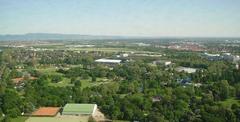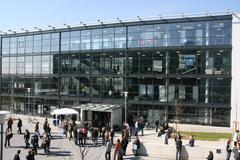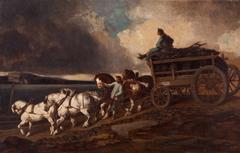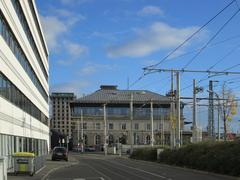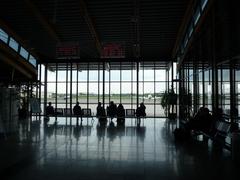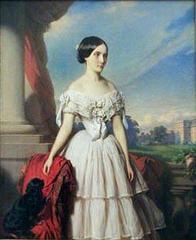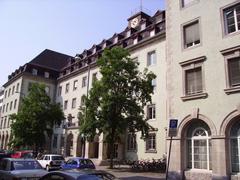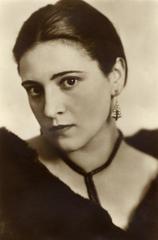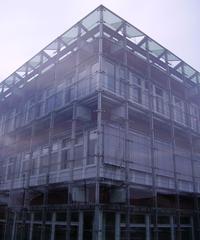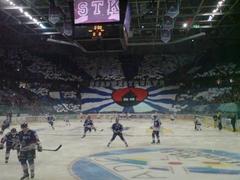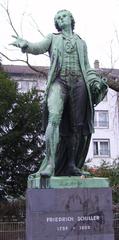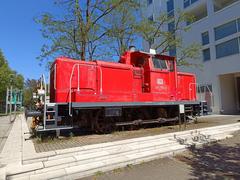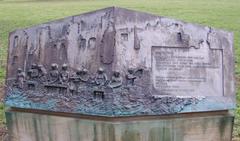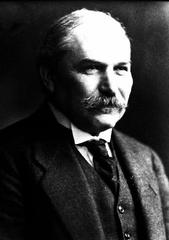
Watertower of Mannheim: Visiting Hours, Tickets, and Historical Significance
Date: 04/07/2025
Introduction
The Watertower of Mannheim (Wasserturm Mannheim) stands as the city’s most recognized landmark, embodying over a century of architectural innovation, historical resilience, and cultural vibrancy. Situated at the heart of Friedrichsplatz—one of Europe’s most celebrated Art Nouveau squares—the tower was constructed between 1886 and 1889, originally serving as a critical water reservoir for a rapidly modernizing city. Today, it remains a focal point not just as a feat of engineering but as a symbol of Mannheim’s urban identity, community spirit, and evolving cultural life (Mannheim Tourism Official Site; Wasserturm Mannheim Official Site). This guide provides a comprehensive overview of the Watertower’s history, architectural features, visiting hours, ticketing, accessibility, nearby attractions, and practical tips for visitors.
Table of Contents
- Historical Background
- Visitor Information
- Symbolism and Urban Role
- Photography and Events
- FAQs
- Plan Your Visit
- References
Historical Background
Origins and Construction
The Watertower was designed by Gustav Halmhuber and built between 1886 and 1889 to address Mannheim’s urgent need for clean and reliable water. Standing at 60 meters high and constructed with robust yellow sandstone, the tower initially stored up to 2,000 cubic meters of water, utilizing its elevation for efficient distribution across the city’s rapidly growing neighborhoods (e-a-a.com; the-passenger.de).
Architectural Style
The Wasserturm is celebrated for its harmonious blend of Romanesque, Art Nouveau (Jugendstil), and Neo-Baroque elements. Its rounded arches and robust form reflect Romanesque roots, while the dome, balustrades, and intricate sculptural decorations—such as the copper statue of Amphitrite, wife of Poseidon—exemplify Art Nouveau’s organic motifs and the grandeur of Neo-Baroque (mannheimer-quadrate.de; pineqone.com). The surrounding Friedrichsplatz features symmetrical flowerbeds, fountains, and arcades, resulting from a citywide vision to create an urban masterpiece.
Wartime Impact and Restoration
During World War II, the tower sustained damage but was spared from destruction. In 1956, a public referendum secured its preservation, and restoration was completed in 1963, including a replica of the Amphitrite statue. The site has been under heritage protection since 1987 (the-passenger.de).
Cultural Evolution
No longer required for municipal water supply, the Watertower was repurposed as a restaurant and event venue. It is now a hub for public gatherings, festivals, and cultural life, surrounded by the lively Friedrichsplatz gardens (Wasserturm Mannheim Official Site).
Visitor Information
Visiting Hours and Tickets
- Friedrichsplatz Gardens and Watertower Exterior: Open to the public year-round, 24/7.
- Restaurant and Interior Access: Generally open daily from 10:00 AM to 10:00 PM; hours may vary for special events and holidays. Interior access is typically reserved for special events or guided tours—check the official tourism website for details.
- Tickets:
- Gardens/exterior: Free.
- Interior: Guided tours and special events may require tickets, available online or at the tourist information center.
- Restaurant: Reservations are recommended, especially on weekends and during events (triplyzer.com).
Accessibility
- Gardens and exterior: Fully wheelchair accessible with paved paths and ramps.
- Interior/upper levels: Accessibility may be limited due to the historic structure; contact the venue in advance if you require assistance (germanydestinattions.com).
Guided Tours and Events
- Guided Tours: Offered seasonally by the Mannheim tourism office, with options in German and, upon request, English (mycityquest.com).
- Events: The Watertower and surrounding square host open-air concerts, art fairs, festivals (including the renowned Christmas Market), and water shows throughout the year (christmasmarketsineurope.com).
Nearby Attractions
- Kunsthalle Mannheim: Modern and contemporary art museum, 3 minutes’ walk.
- Mannheim Palace (Schloss Mannheim): One of Europe’s largest Baroque palaces.
- National Theatre Mannheim: Historic theatre and opera house.
- Reiss Engelhorn Museum: Archaeology, art, and cultural history.
- Botanical Garden Mannheim: Lush city gardens (thetouristchecklist.com; trek.zone).
Symbolism and Urban Role
The Watertower is Mannheim’s most iconic symbol, featured in city branding, postcards, and souvenirs. It stands as a testament to the city’s resilience, modernization, and civic pride. Its central location at Friedrichsplatz makes it the heart of public life, hosting festivals, markets, and community celebrations. The site’s enduring popularity is reflected in visitor testimonials and its status as one of Germany’s most important Art Nouveau monuments (facts.net; 1xmarketing.com).
Photography and Events
The Watertower’s architectural beauty, especially at sunrise and dusk, makes it a favorite among photographers, artists, and social media enthusiasts. The interplay of illuminated fountains, flowerbeds, and the sandstone tower creates a picturesque scene year-round. Major events like the Mannheim Christmas Market and summer concerts draw large crowds and transform the square into a vibrant urban stage (mycitytrip.net).
For the best photos, visit early in the morning or at dusk. Virtual tours and official image galleries are available via the tourism website.
FAQs
Q: What are the Watertower Mannheim visiting hours?
A: The exterior and gardens are open 24/7, year-round. Interior access is available during guided tours and special events—check the official site for current schedules.
Q: Is there an entrance fee?
A: No fee for gardens or exterior. Guided tours and events may require tickets.
Q: Is the site wheelchair accessible?
A: The gardens and exterior are accessible; interior access may be limited.
Q: Are guided tours available in English?
A: Yes, request in advance via the tourism office.
Q: What are the best times to visit?
A: Spring and summer for gardens and fountains; late November–December for the Christmas Market.
Q: How do I get there?
A: Centrally located at Friedrichsplatz, 10 minutes’ walk from Mannheim Hauptbahnhof; well-served by tram and bus (triphobo.com).
Plan Your Visit
- Book in Advance: Reserve guided tours and restaurant tables ahead of time, especially during peak seasons.
- Combine Attractions: Visit the Kunsthalle Mannheim, Mannheim Palace, or shop at Planken for a full city experience.
- Stay Informed: Check official tourism resources for up-to-date hours, event listings, and accessibility information.
- Travel Tips: Wear comfortable shoes, plan for weather, and allow time to explore the gardens and nearby attractions.
Download the Audiala app for self-guided audio tours, notifications on upcoming events, and exclusive content about Mannheim’s historical and cultural sites.
References
- 10 Best Architectural Buildings in Mannheim, Germany
- Mannheim Tourism Official Site
- Wasserturm Mannheim Official Site
- Mannheim Water Tower: Architectural Marvel and Must-Visit Historical Site
- Watertower of Mannheim: Visiting Hours, Tickets, and Cultural Significance
- Watertower Mannheim Visiting Hours, Tickets & Guide to Mannheim Historical Sites
- Friedrichsplatz – Water Tower
- Kunsthalle Mannheim
- Mannheim Christmas Market
- Water Tower Statistics
- Local Lifestyles: Mannheim Cultural Guide
- Dining and Attractions
- Accessibility and Travel
- MyCityQuest Guide















